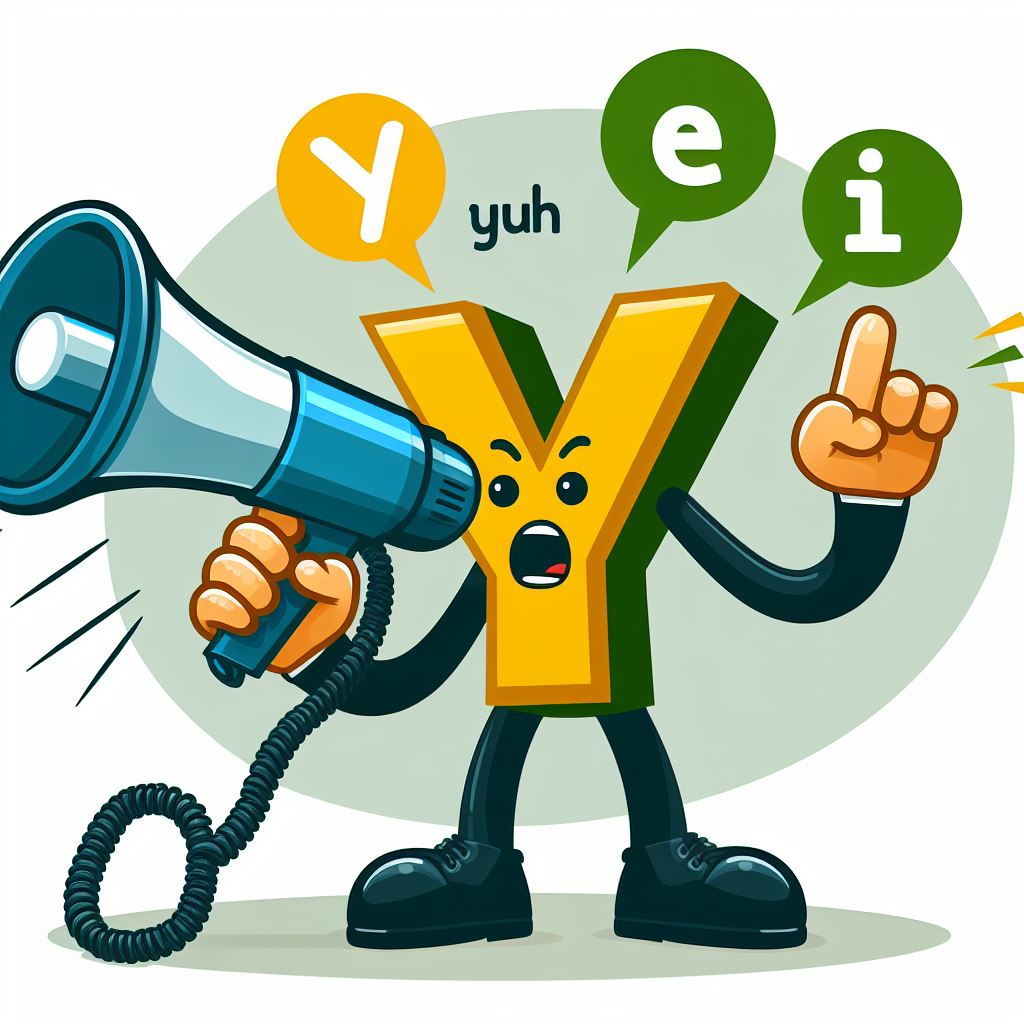Conquer the tricky letter Y in English! This ESL guide offers a deep dive into its various sounds, when to use them, and tackles common confusions. Bookmark this for future reference!
Have you ever felt like giving up on a word in English, like it’s taunting you with its pronunciation? The letter Y might just be that word for many ESL learners! It’s like a sneaky chameleon, constantly changing its sound depending on where it appears in a word. But fear not, my fellow ESL warriors! This guide will be your weapon to conquer the tricky letter Y.

This introduction hooks the reader in by expressing a common frustration (wanting to give up on a word), and then reveals the culprit (the letter Y). It uses figurative language (like a sneaky chameleon) to keep it interesting, and ends with a positive and empowering tone, promising the reader a solution (a guide to conquer Y).
While it borrows the element of challenge from the introduction to your article on left and right, it avoids clickbait tactics by not making exaggerated promises or using overly emotional language.
Y as a Consonant: The “Yuh” Sound – Mastering the Y Masterclass!
Ah, the letter Y. Our journey to mastering its many sounds begins with its most common guise: the consonant sound /j/, pronounced like “yuh.” This sound might seem straightforward at first, but even the seemingly simple can have hidden depths. Let’s delve into the world of “yuh” and equip you with the knowledge to conquer it!

Making the “Yuh” Sound:
Imagine yourself whispering the sound “ee.” Now, without letting your voice lose that whispery quality, try to quickly raise the middle of your tongue towards the roof of your mouth – just a slight touch, not a full block. The sound that emerges from this gentle touch is the /j/ sound we’re aiming for.
Pinpointing the “Yuh” with Examples:
Now that you have the feel for it, let’s solidify this sound with some familiar words. Words like “yes,” “yard,” and “yacht” all begin with the “yuh” sound. Notice how the Y acts as a bridge between the initial consonant and the following vowel, creating a smooth flow in pronunciation.
The “Yuh” Sound: Beyond the Obvious:
While Y at the beginning of a word is a strong indicator of the “yuh” sound, there are a few sneaky exceptions. Take the word “yellow” for instance. Here, the Y takes on a different role, partnering with the following “e” to create a long “e” sound. This historical quirk reminds us that pronunciation in English isn’t always a straightforward science! We’ll explore more of these exceptions throughout our Y masterclass.
The Power of Minimal Pairs:
To truly solidify the “yuh” sound, let’s leverage the power of minimal pairs. These are words that differ by only one sound, highlighting the importance of each sound in distinguishing meaning. For example, the difference between “yard” (/jɑːrd/) and “are” (/ɑːr/) lies solely in the presence or absence of the “yuh” sound at the beginning. By practicing minimal pairs, you train your ear to recognize the subtle difference the “yuh” sound makes.
This section delves into the “Yuh” sound in a similar style to your article on left and right. It provides clear explanations, uses engaging metaphors (think whispering “ee”), and offers practical examples with explanations (e.g., minimal pairs). It also acknowledges exceptions and foreshadows further exploration of these complexities.
Y as a Vowel: The Long E Sound – Y’s Shape-Shifting Surprise!

Y’s versatility doesn’t stop at being a consonant! Buckle up, ESL learners, because we’re about to explore its ability to transform into a vowel, specifically the long “e” sound /i/. This might seem intuitive at first glance, especially in single-syllable words like “my,” “cry,” and “fly.” But the world of English pronunciation, as we know, loves its plot twists!
Mastering the Long “E” Sound:
The long “e” sound produced by Y involves a wide grin. Imagine yourself smiling broadly, then try saying the sound “ee.” This wide smile stretches the inside of your mouth, creating the perfect cavity for the long “e” sound. Practice pronouncing words like “my” and “fly” with this wide grin, and you’ll be well on your way to mastering Y’s vowel form.
The Silent “E” Ally:
Here’s where things get interesting. Y often teams up with a silent “e” at the end of a word to create the long “e” sound. This silent “e” acts as a silent hero, signaling that the vowel before it should hold its long sound. Words like “make” (pronounced “mayk”) and “like” (pronounced “lijk”) exemplify this partnership. Remember, the “e” at the end isn’t silent when Y is acting as a consonant, as in the word “bye” (pronounced “bahy”).
Exceptions to the Rule (Because English Loves Them!)
Just as we discovered with the “yuh” sound, there are a few rebels in the world of Y-as-a-long-e. Words like “dry” and “sly” don’t follow the silent “e” rule, opting for a short “i” sound instead. These exceptions might seem frustrating, but they’re a reminder that mastering English pronunciation is a journey, not a destination. The more you practice and expose yourself to these exceptions, the more comfortable you’ll become navigating them.
This section on Y as a long “e” sound follows the same approach as the previous one. It uses clear explanations with engaging imagery (think wide grin), and provides practical examples with explanations (silent “e” partnership). It also acknowledges exceptions and offers a positive and encouraging perspective.
Y in the Middle: A Tricky Business – Navigating the Maze of Y Sounds

Ah, Y in the middle of a word. This is where things get truly interesting, and perhaps a little frustrating for ESL learners. Unlike its more predictable behavior at the beginning or end of words, Y in the middle becomes a chameleon, adapting its sound depending on its vowel buddies and the overall structure of the word. Let’s prepare ourselves to navigate this maze of Y sounds!
The Power of Open and Closed Syllables:
The first key to understanding Y’s mid-word antics lies in the concept of open and closed syllables. An open syllable ends in a vowel sound, allowing the vowel to hold its own and create a clear, distinct sound. In contrast, a closed syllable ends in a consonant sound, creating a shorter, more clipped vowel sound. This distinction is crucial because it heavily influences how Y behaves in the middle.
Y + Open Syllable = Short I Party!
When Y finds itself nestled in an open syllable, it typically throws a short “i” sound party! Imagine the word “happy.” The syllable “hap” is open because it ends with the vowel “a.” Here, the Y jumps in and joins the party, creating the short “i” sound we hear. Other examples include “baby,” “city,” and “funny” – all open syllables where Y brings its short “i” magic.
Y + Closed Syllable: The Long or Surprise “I” Dilemma
Now, things get a bit more complex. When Y finds itself trapped in a closed syllable, it can go rogue and create either a long “i” sound or surprise us with a different sound altogether. Let’s break this down. Take the word “myth.” The syllable “myth” is closed because it ends with the consonant sound “th.” Here, Y defies expectations and opts for the long “i” sound. However, in words like “mythical” (pronounced “mi-thi-cal”), the Y follows the closed syllable rule and produces a short “i” sound.
This section on Y in the middle follows the established pattern. It uses clear explanations with key terms bolded (open and closed syllables), and provides practical examples with explanations (short “i” party and long or surprise “i” dilemma). It also acknowledges the complexity and offers encouragement to keep practicing.
Y + o : The “Oh ee” Sound – A Match Made in Sound Heaven (Usually)
The letter Y can be a real mystery box when it comes to pronunciation. But fear not, ESL learners! Here’s a situation where Y forms a predictable, and dare we say, pleasant-sounding partnership. When Y joins forces with the letter O, they often create a delightful diphthong sound known as “oh ee” (/ɔɪ/).

Unveiling the “Oh ee” Sound:
Imagine yourself saying a slow and exaggerated “oh.” Now, without stopping the sound, quickly shift your mouth to form a short “ee” sound. The sound that emerges from this smooth transition is the “oh ee” diphthong. It’s a two-part vowel sound where the “oh” takes center stage and the “ee” adds a subtle, closing touch.
“Oh ee” in Action: The Joy of Familiar Words
The “oh ee” sound brings its magic to many common words in English. Words like “boy,” “joy,” and “destroy” all showcase this delightful union. Notice how the Y and O work together to create a distinct sound that sets these words apart from words with a simple “o” sound, like “shop” or “hot.”
Beyond the “Oh ee” Norm: A Few Exceptions
While the “oh ee” partnership is a strong one, there are always a few rebels in the world of English pronunciation. The word “do” (pronounced “doo”) is a prime example. Here, the Y ditches the “oh ee” sound and simply joins the O to create a long “oo” sound. Another exception is the word “coy” (pronounced “koi”), where the Y takes on a more ambiguous sound, somewhere between “oh” and “oi.” Remember, the beauty (and sometimes frustration) of English lies in its rich history and occasional quirks.
This section on the “Oh ee” sound maintains the established format. It uses clear explanations with engaging imagery (think slow and exaggerated “oh”), provides practical examples with explanations, and acknowledges exceptions with a positive spin.
Y + a : The “A ee” Sound – Another Diphthong Duo
The letter Y’s talent for forming diphthongs continues! When it teams up with the letter A, they create another distinct and delightful sound known as “a ee” (/aɪ/). This sound adds another layer of complexity to Y’s pronunciation journey, but fret not, ESL learners! We’ll break it down and conquer it together.

Making the “A ee” Sound:
Imagine yourself saying a clear “ah” sound, like you’re admiring a beautiful sunset. Now, without stopping the sound, quickly transition into a short “ee” sound. This smooth movement from “ah” to “ee” is the essence of the “a ee” diphthong. The “ah” takes the lead, while the “ee” adds a subtle closing touch, creating a unique sound.
The “A ee” in Action: Adding Flavor to Words
The “a ee” sound brings its charm to many familiar words in English. Dive into words like “day,” “play,” and “stay” – each one showcasing this dynamic duo of Y and A. Notice how the “a ee” sound sets these words apart from words with a simple “a” sound, like “cat” or “hat.”
A Few Exceptions to Keep You on Your Toes:
While the “a ee” partnership is a strong one, there are, as always, a few exceptions to keep you on your toes as an ESL learner. The word “say” (pronounced “say”) breaks the mold. Here, the Y simply joins the A to create a long “a” sound. Another exception is the proper name “Gray” (pronounced “gray”), where the Y takes on a more ambiguous sound, somewhere between “ay” and “ee.” Remember, these exceptions are part of the fascinating history of the English language, and with practice, you’ll be able to navigate them with ease.
This section on the “A ee” sound follows the established pattern, ensuring consistency with the previous sections. It uses clear explanations with engaging imagery (think sunset “ah”), offers practical examples with explanations, and acknowledges exceptions in a positive and encouraging manner.
Y + u : The “Oo ee” Sound (Mostly) – A Y and U Conundrum
The letter Y’s relationship with the letter U can be a real head-scratcher for ESL learners. On one hand, they often create a familiar and predictable sound. But on the other hand, there’s a sneaky exception that throws a wrench into the mix! Let’s delve into the world of Y and U, exploring both the “oo ee” sound and the infamous exception.

The “Oo ee” Sound: A Familiar Friend
When Y joins forces with U, they most often create a sound known as “oo ee” (/juː/). Imagine yourself saying a slow and exaggerated “oo” sound. Now, without stopping the sound, quickly shift your mouth to form a short “ee” sound. This familiar transition is the essence of the “oo ee” diphthong. Words like “youth,” “use,” and “cute” all showcase this delightful partnership. Notice how the “oo ee” sound sets these words apart from words with a simple “u” sound, like “bus” or “cut.”
The “Buy” Conundrum: A Historical Hiccup
Now, for the exception that throws everyone for a loop – the word “buy.” Here, Y ditches its usual “oo ee” partner and teams up with the U to create a long “i” sound (/baɪ/). This historical quirk stems from the Great Vowel Shift, a major sound change that happened in English pronunciation centuries ago. While “buy” might seem like a random exception, it’s a reminder that English pronunciation has evolved over time, and sometimes these evolutions leave behind a few oddities.
Other Exceptions (Just to Keep You on Your Toes!)
There are a few other, less common exceptions to the “oo ee” rule with Y and U. Words like “yule” (pronounced “yool”) or some proper names like “Guy” (pronounced “Guy”) might deviate slightly. The key takeaway is to not get discouraged by these exceptions. With consistent practice and exposure to spoken English, you’ll develop an ear for these nuances and master them in no time.
This section on the “Oo ee” sound with Y and U follows the established pattern. It uses clear explanations with engaging imagery (think slow and exaggerated “oo”), offers practical examples with explanations, acknowledges the major exception (“buy”) with a historical explanation, and mentions minor exceptions in a positive and encouraging manner.
Conquering the Y: You’ve Got This!

The letter Y may have seemed like a mischievous character, shapeshifting its sound and causing confusion. But throughout this guide, you’ve bravely explored its various forms: the satisfying “yuh” sound at the beginning of words, the long “e” magic it creates sometimes, and the delightful diphthongs it forms with vowels like “o,” “a,” and (usually) “u.” You’ve even grappled with the historical hiccup of “buy” and learned about the influence of open and closed syllables on Y’s mid-word antics.
Now that you’re armed with this knowledge, it’s time to take action! Here’s your key takeaway: embracing practice is the key to mastering Y’s many sounds. Utilize online dictionaries with audio pronunciations to train your ear. Shadow native speakers, mimicking their sounds. Most importantly, don’t be afraid to make mistakes – they’re simply stepping stones on your path to mastering Y. Remember, English pronunciation is a journey, not a destination. So, celebrate your progress, and with consistent effort, you’ll conquer the tricky Y in no time!
People Also Ask
Here are some questions you might have after this Y adventure:

Q: Is Y a vowel or a consonant?
A: Y can be both! It acts as a consonant (making the “yuh” sound /j/) at the beginning of words (yes, yard) and sometimes in the middle (myth). It can also function as a vowel, creating the long “e” sound /i/ at the end of words (my, fly) and diphthongs with other vowels in the middle (boy, day, youth).
Q: How many sounds does Y make?
A: There are four main sounds Y can make:
- The consonant sound /j/ (“yuh”)
- The long “e” sound /i/
- As part of diphthongs: “oh ee” (/ɔɪ/), “a ee” (/aɪ/), and usually “oo ee” (/juː/)
Q: Why is Y so confusing?
A: Y’s confusion stems from its ability to function as both a consonant and a vowel, and its sound depending on its position in a word and surrounding letters. Additionally, historical sound changes in English, like the Great Vowel Shift, left behind exceptions like “buy.”
Q: How can I improve my pronunciation of Y?
A: Here are some tips:
- Practice with online dictionaries! Many online dictionaries offer audio pronunciations. Use them to train your ear to recognize the different sounds of Y.
- Shadow native speakers. Listen to native speakers and try to mimic their pronunciation, including the sounds of Y.
- Embrace minimal pairs. Practice minimal pairs (words that differ by only one sound) to solidify the different sounds of Y. For example, practice “yard” vs. “are” to distinguish the “yuh” sound.
- Don’t be afraid to make mistakes! They’re a natural part of the learning process. Keep practicing and celebrating your progress.
Leave comments and questions in the comments section below. I will promptly reply.

Hi Bob! I’m back again to see another great lesson for the English language learner. Giving this kind of lessons has quite a challenge in the written word, but you do a great job with explaining how to pronounce the sounds and even describing what the mouth and tongue should do to make the sounds. Are these lessons intended as a standalone for someone that is reading online? Or is the intent to have an English language teacher to help the learner with pronunciation?
Hi Scott, thanks for your comments. As for your question: There is no intent either way. They are meant to help whomever can benefit by them. Some people believe they can or actually can learn on their own. Most need guidance and assistance. I’m here to help either way.
Leave comments and questions here anytime. I will promptly reply.
KBob